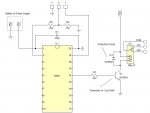trevorboultwood
Member
Hello all!
I was wondering if anyone could help me, for my systems a level project I need to switch on a relay with a PICAXE. I have tried to connect a pin on chip to a resistor which goes in to a darlington pair transistor. Which 12v is connected to its collector, then the collector through the relay and then to ground.
I have tried with all sorts of values of resistors on the base(remember I have 5) and Nottingham worked. Is there another solution or what can I do. I appreciate all your help.
I was wondering if anyone could help me, for my systems a level project I need to switch on a relay with a PICAXE. I have tried to connect a pin on chip to a resistor which goes in to a darlington pair transistor. Which 12v is connected to its collector, then the collector through the relay and then to ground.
I have tried with all sorts of values of resistors on the base(remember I have 5) and Nottingham worked. Is there another solution or what can I do. I appreciate all your help.


